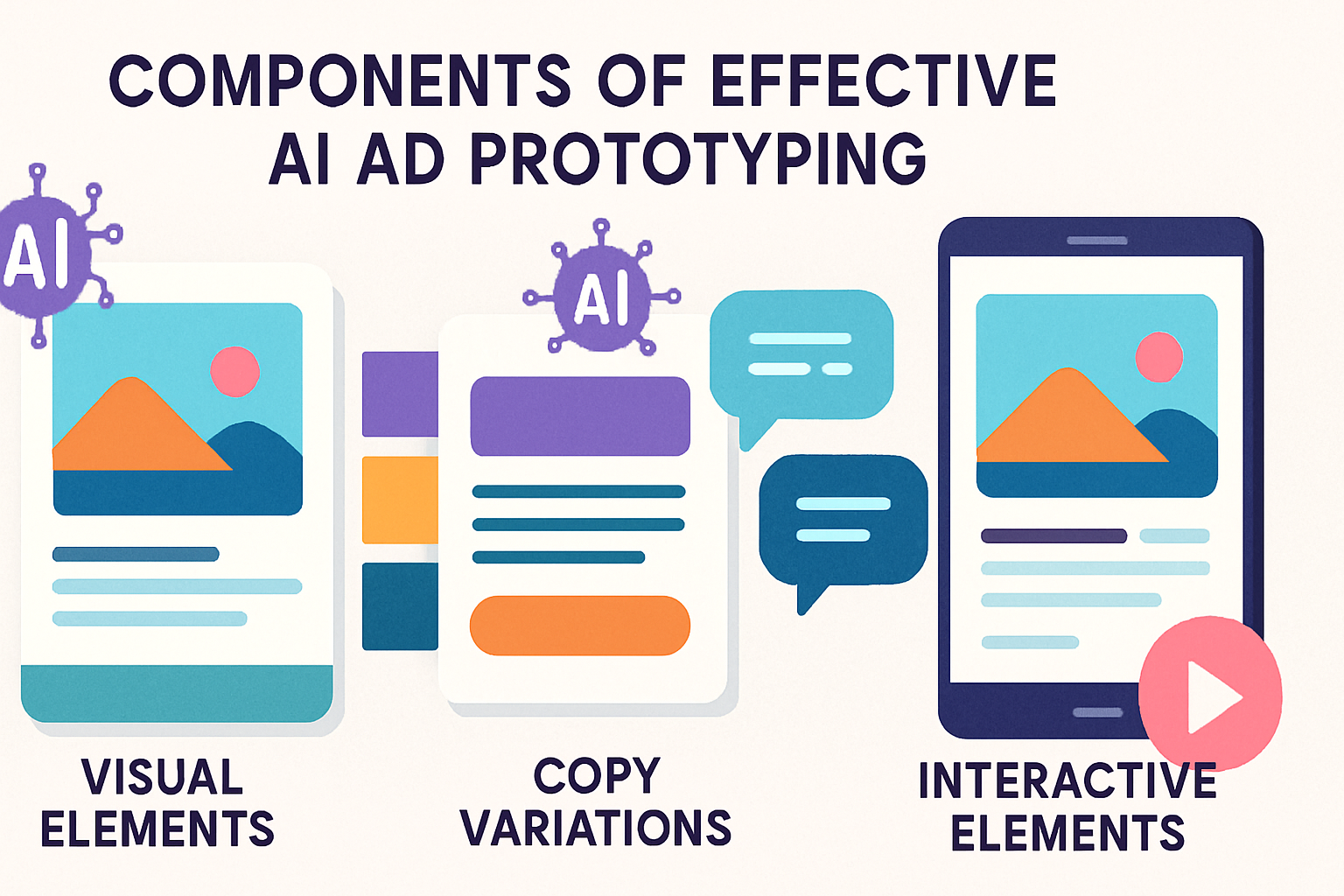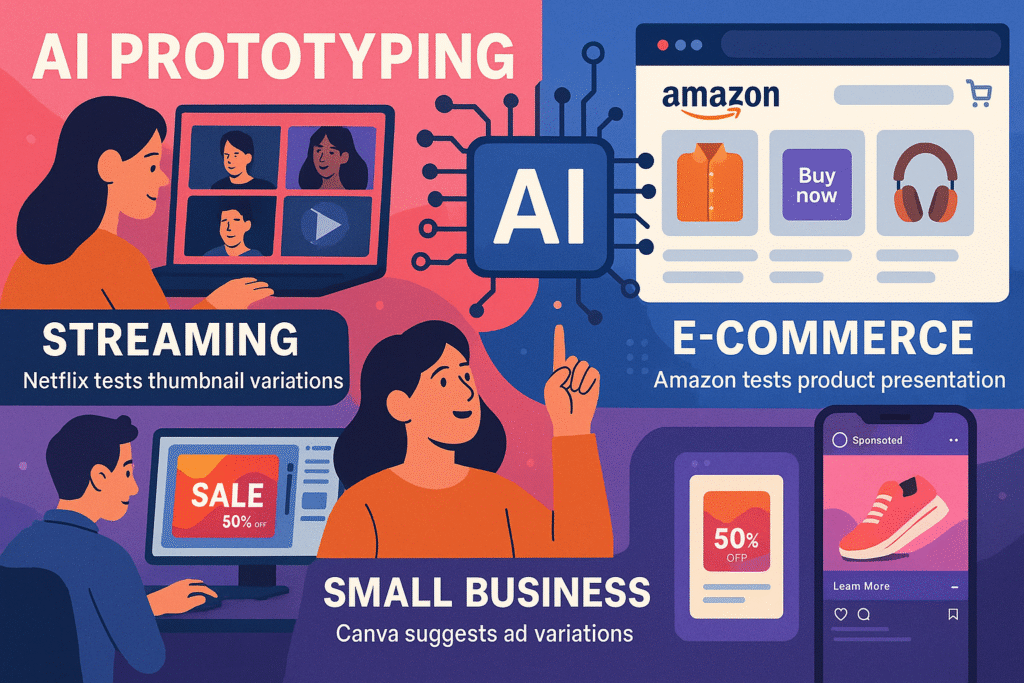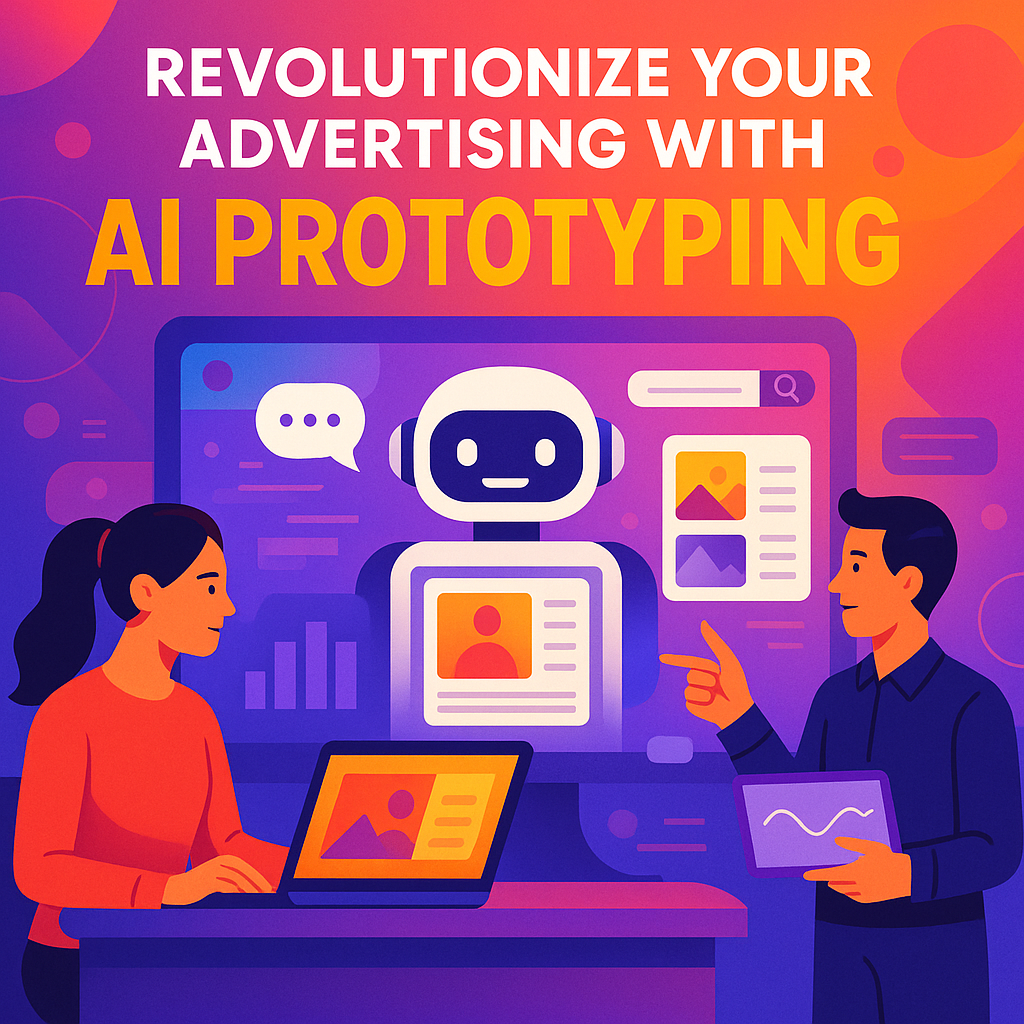Table of Contents
AI prototyping has become the secret weapon for marketers who want to test multiple ad variations without burning their budgets. Gone are the days when creating dozens of ad concepts meant weeks of design work and massive costs. Today’s artificial intelligence tools can generate, test, and optimize advertising content in hours rather than months.
The traditional advertising approach of creating one perfect ad and hoping it works is dead. Modern consumers scroll past thousands of ads daily, making it harder than ever to capture attention. Smart marketers now rely on rapid testing methods to find winning combinations before investing in full campaigns.
Need of AI Prototyping for Modern Advertising
Traditional prototyping methods require significant time and resources. Designers spend hours crafting each variation, copywriters test different headlines, and creative teams debate color schemes. This process often takes weeks for just a handful of concepts.
AI prototyping changes this equation completely. Machine learning algorithms can analyze successful ad patterns and generate dozens of variations in minutes. These tools examine everything from color psychology to text placement, creating options that might never occur to human designers.
The speed advantage alone makes AI prototyping invaluable. While competitors spend weeks perfecting single campaigns, AI-powered teams test hundreds of variations. This rapid iteration leads to better performance and higher conversion rates.
Components of Effective AI Ad Prototyping

Successful AI prototyping requires understanding the key elements that drive ad performance. Visual components, copy variations, and interactive elements each play crucial roles in capturing audience attention.
Visual elements form the foundation of any effective ad. AI tools can generate designs with different color schemes, layouts, and imagery styles. These variations help identify which visual approaches resonate with target audiences before full production begins.
Copy testing represents another critical component. AI systems can generate headlines, body text, and call-to-action phrases based on successful patterns. This approach ensures every text element gets optimized for maximum impact.
Brand consistent visuals remain important even when using AI generation. The technology should enhance creative processes while maintaining recognizable brand elements across all variations.
Advanced Techniques for Generate Designs with AI
Modern AI design tools offer sophisticated capabilities for creating ad variations. These platforms analyze thousands of successful advertisements to understand what works across different industries and demographics.
Color psychology plays a major role in AI design generation. Algorithms consider how different colors affect emotional responses and purchasing decisions. Red might increase urgency for sales promotions, while blue builds trust for financial services.
Layout optimization represents another strength of AI design tools. These systems test different element placements to maximize visual hierarchy and user attention flow. The result is ads that guide viewers naturally toward desired actions.
Typography choices significantly impact ad performance. AI tools can test various font combinations, sizes, and weights to find the most readable and persuasive text presentations. This level of detail testing would be impossible with manual methods.
Creating Dynamic Interactions Through AI
Interactive elements separate memorable ads from forgettable ones. AI prototyping tools can generate various interaction patterns to test which approaches drive the highest engagement rates.
Hover effects and micro-animations add polish to digital advertisements. AI systems can create subtle movements that draw attention without being distracting. These small touches often make the difference between ads that get clicked and those that get ignored.
Progressive disclosure techniques work particularly well for complex products or services. AI can test different ways of revealing information gradually, keeping viewers engaged while building interest. This approach prevents overwhelming audiences with too much information at once.
Creating immersive content becomes easier when AI handles the technical aspects of interaction design. Marketing teams can focus on strategic decisions while algorithms optimize the user experience details.
Improving Animation Effectiveness
Animation quality can make or break modern advertising campaigns. AI prototyping tools excel at creating smooth, purposeful animations that enhance rather than distract from core messages.
Motion principles guide effective animation creation. AI systems understand concepts like easing, timing, and secondary animation to create natural-feeling movements. These principles ensure animations feel polished and professional rather than amateur.
Performance considerations become crucial for animated ads. AI tools can optimize file sizes and loading times while maintaining visual quality. This balance ensures ads load quickly across all devices and connection speeds.
Testing different animation speeds helps identify optimal pacing for target audiences. Some demographics prefer quick, energetic movements, while others respond better to slower, more deliberate animations. AI can test these variations systematically.
| Animation Type | Best Use Case | Performance Impact |
|---|---|---|
| Micro-animations | UI feedback, hover states | Minimal |
| Loading animations | Data processing, form submissions | Low |
| Scroll animations | Storytelling, product reveals | Medium |
| Full-screen animations | Brand experiences, product launches | High |
Measuring Success Through AI-Powered Analytics
Testing ad variations means nothing without proper measurement systems. AI analytics tools can track performance metrics across multiple dimensions simultaneously, providing insights that manual analysis would miss.
Engagement metrics tell part of the story but conversion tracking reveals the complete picture. AI systems can correlate specific design elements with actual purchase behaviors, identifying which variations drive real business results rather than just clicks.
A/B testing becomes more sophisticated with AI assistance. Instead of testing just two versions, algorithms can run multivariate tests with dozens of elements changing simultaneously. This approach reveals complex interactions between different design components.
AI-powered campaign success analytics provide deeper insights than traditional metrics alone. These systems can predict which variations will perform best with specific audience segments before full deployment.
Real-World Case Studies and Applications

Netflix uses AI prototyping extensively for their promotional materials. The streaming giant tests thousands of thumbnail variations for each show, using algorithms to identify which images drive the highest click-through rates for different viewer segments.
E-commerce brands like Amazon rely on AI to test product presentation variations. Their systems generate different layouts, color schemes, and call-to-action buttons to optimize conversion rates across millions of product pages.
Social media platforms have embraced AI for ad format testing. Instagram and Facebook use machine learning to determine which ad formats perform best for different business types and campaign objectives.
Small businesses can also benefit from AI prototyping tools. Platforms like Canva and Adobe Creative Suite now offer AI-powered design suggestions that help smaller teams create professional-quality ad variations without large design budgets.
Integration with Existing Marketing Workflows
Successful AI prototyping requires seamless integration with current marketing processes. Teams need systems that enhance rather than replace their existing creative workflows.
Content management becomes crucial when dealing with dozens of ad variations. AI tools should integrate with existing asset libraries and brand guidelines to ensure consistency across all generated content.
Approval workflows need updating to handle the volume of variations AI can produce. Teams must develop efficient review processes that maintain quality while allowing rapid iteration and testing.
Brand storytelling principles should guide AI prototyping efforts. Technology should amplify brand messages rather than creating generic content that lacks personality or connection to company values.
Technical Implementation and Best Practices
Setting up effective AI prototyping requires careful planning and technical considerations. Teams need robust infrastructure to handle the computational demands of generating and testing multiple variations simultaneously.
Data quality directly impacts AI prototyping success. Systems need access to high-quality training data, including successful ad examples, brand guidelines, and target audience information. Poor input data leads to poor output variations.
Version control becomes critical when managing multiple AI-generated variations. Teams need systems to track which elements perform best and why, enabling continuous improvement of the AI generation process.
Privacy considerations affect how AI systems collect and use customer data for ad optimization. Companies must ensure their prototyping processes comply with data protection regulations while still gathering useful insights.
Budget Optimization Through Smart Testing
AI prototyping delivers significant cost savings compared to traditional ad development methods. Instead of paying designers to create dozens of variations manually, teams can generate hundreds of options for the cost of software subscriptions.
Resource allocation improves when AI handles routine variation creation. Human creatives can focus on strategic thinking and concept development while algorithms handle execution details and optimization tasks.
Time-to-market advantages compound over multiple campaigns. Teams using AI prototyping can launch new campaigns weeks faster than competitors using traditional methods, capturing market opportunities before others respond.
Multimedia marketing strategies benefit from AI’s ability to create variations across different media types simultaneously. Single campaigns can span video, static images, and interactive formats with consistent messaging.
Common Challenges and Solutions
Quality control presents ongoing challenges when generating large numbers of AI variations. Teams need robust review processes to ensure all generated content meets brand standards and quality expectations.
Brand consistency can suffer when AI generates too many radical variations. Successful implementations balance creative exploration with adherence to established brand guidelines and visual identity systems.
Performance prediction accuracy improves with more data and testing. Initial AI prototyping efforts may produce mixed results, but systems become more effective as they learn from campaign performance data.
Designing impactful visuals requires human oversight even with AI assistance. Creative teams must guide AI tools toward brand-appropriate solutions while allowing for innovative approaches.
Performance Check and Enhancement
Establishing baseline performance metrics helps evaluate AI prototyping success. Teams need clear measurements of current ad performance before implementing new testing methodologies.
Competitive analysis becomes easier when AI can generate variations based on successful competitor strategies. These tools can identify effective patterns across industries while maintaining brand uniqueness.
Continuous improvement requires systematic analysis of what works and what doesn’t. Successful teams regularly review AI-generated variation performance to refine their algorithmic approaches.
| Metric | Traditional Method | AI Prototyping | Improvement Factor |
|---|---|---|---|
| Variations Created | 5-10 per week | 50-100 per day | 50x |
| Testing Time | 4-6 weeks | 1-2 weeks | 3x |
| Cost per Variation | $200-500 | $10-50 | 10x |
| Performance Improvement | 10-20% | 30-50% | 2.5x |
Conclusion
AI prototyping has transformed how smart marketers approach ad testing and optimization. The ability to generate dozens of variations quickly and cost-effectively gives businesses unprecedented advantages in today’s competitive landscape.
Success requires balancing technological capabilities with human creativity and strategic thinking. AI handles the repetitive tasks while humans focus on big-picture strategy and brand consistency. This collaboration produces better results than either approach alone.
The future belongs to marketers who embrace these tools while maintaining focus on genuine customer value. AI prototyping should enhance rather than replace human insight, creating more effective advertising that resonates with real audiences.
Start implementing AI prototyping gradually, testing tools and processes with smaller campaigns before scaling up. Focus on measuring results and refining approaches based on actual performance data. The investment in learning these systems will pay dividends across all future marketing efforts.
Begin with one simple AI prototyping tool and expand your capabilities as you see results. The competitive advantages are too significant to ignore, and the technology is mature enough for immediate implementation.
Frequently Asked Questions
How much does AI prototyping cost compared to traditional methods?
AI prototyping typically costs 60-80% less than traditional design methods. While software subscriptions range from $50-500 monthly, they replace thousands in design fees. Most businesses recover their investment within the first campaign.
Can AI prototyping maintain brand consistency?
Yes, modern AI tools can learn and apply brand guidelines automatically. Teams input brand colors, fonts, and style preferences once, then AI generates variations that stay within those parameters. Human oversight ensures quality control.
How quickly can AI generate ad variations?
Most AI prototyping tools generate 10-50 variations within minutes. Complex animations or interactive elements might take hours rather than minutes, but this still represents massive time savings over manual creation methods.
What types of ads work best with AI prototyping?
Display ads, social media posts, and email marketing perform exceptionally well with AI prototyping. Video ads and complex interactive experiences require more human oversight but still benefit from AI assistance in concept development.
Do AI-generated ads perform better than human-designed ones?
AI-generated ads often outperform traditional designs because they’re based on data from thousands of successful campaigns. However, the best results come from combining AI efficiency with human creativity and strategic thinking.
How do I measure the success of AI prototyping efforts?
Focus on conversion rates, engagement metrics, and cost-per-acquisition rather than just click-through rates. Compare these metrics against previous campaigns to measure improvement. Most successful implementations see 25-40% performance increases.
